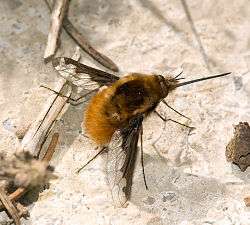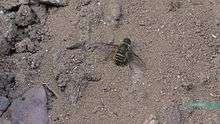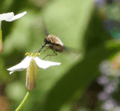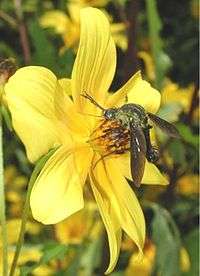Bombyliidae
| Bombyliidae | |
|---|---|
 | |
| Bombylius major | |
| Scientific classification | |
| Kingdom: | Animalia |
| Phylum: | Arthropoda |
| Class: | Insecta |
| Order: | Diptera |
| Suborder: | Brachycera |
| Infraorder: | Asilomorpha |
| Superfamily: | Asiloidea |
| Family: | Bombyliidae Latreille, 1802 |
| Subfamilies | |
| |
| Synonyms | |
|
Phthiriidae | |
The Bombyliidae are a family of flies. Their common name is bee flies. Adults generally feed on nectar and pollen, some being important pollinators. Larvae generally are parasitoids of other insects.
Overview
The Bombyliidae are a large family of flies comprising hundreds of genera, but the lifecycles of most species are known poorly, or not at all. They range in size from very small (2 mm in length) to very large for flies (wingspan of some 40 mm).[1][2] When at rest, many species hold their wings at a characteristic "swept back" angle. Adults generally feed on nectar and pollen, some being important pollinators, often with spectacularly long probosces adapted to plants such as Lapeirousia species with very long, narrow floral tubes. In parts of East Anglia, locals refer to them as beewhals, thanks to their tusk-like appendages. Many Bombyliidae superficially resemble bees and accordingly the prevalent common name for a member of the family is bee fly.[2] Possibly the resemblance is Batesian mimicry, affording the adults some protection from predators.
The larval stages are predators or parasitoids of the eggs and larvae of other insects. The adult females usually deposit eggs in the vicinity of possible hosts, quite often in the burrows of beetles or wasps/solitary bees. Although insect parasitoids usually are fairly host-specific, often highly host-specific, some Bombyliidae are opportunistic and will attack a variety of hosts.
While the Bombyliidae include a large number of species in great variety, most species do not often appear in abundance, and for its size this is one of the most poorly known families of insects. At least 4,500 species are described, and certainly thousands yet remain to be described.

Morphology
Adult
Although the morphology of beeflies varies in detail, adults of most bee flies are characterized by some morphological details that make recognition easy. The dimensions of the body vary, depending on the species, from 1.0 mm to 2.5 cm. The form is often compact and the integument is covered with dense and abundant hair. The livery is usually inconspicuous and colours such as brown, blackish- grey, and light colors like white or yellow predominate. Many species are mimics of Hymenoptera Apoidea.
The head is round, with a convex face, often holoptic in males. The antennae are of the type aristate composed of three to six segments, with the third segment larger than the others; the stylus is absent (antenna of three segments) or is composed of one to three flagellomeres (antenna of four to six segments). The mouthparts are modified for sucking and adapted for feeding on flowers. The length varies considerably: for example, the Anthracinae have short mouthparts, with the labium terminating in a large fleshy labellum, in Bombyliinae; in Phthiriinae, the tube is considerably longer, and in Bombyliinae more than four times the length of the head.
The legs are long and thin and the front legs are sometimes smaller and more slender than the middle and rear legs. Typically, they are provided with bristles at the apex of the tibiae, without empodia and, sometimes, also without pulvilli . The wings are transparent, often hyaline or evenly colored or with bands. The alula are well developed and in the rest position the wings are kept open and horizontal in a V shape revealing the sides of the abdomen.
The abdomen is generally short and wide, subglobose-shaped, cylindrical, or conical, composed of six to eight apparent uriti apparent. The remaining urites are part of the structure of the external genitalia. The abdomen of the females often ends with spinous processes, used in ovideposition. In Anthracinae and Bombyliinae, a diverticulum is present in the eighth urite, in which the eggs are mixed with sand before being deposited.
The wing venation, although variable within the family, has some common characteristics that can be summarized basically in the particular morphology of the branches of the radial sector and the reduction of the forking of the media. The costa is spread over the entire margin and the subcosta is long, often ending on the distal half of the costal margin.The radius is almost always divided into four branches, with fusion of the branches R 2 and R 3, and is characterized by the sinuosity of the end portions of the branches of the radial sector. The venation presents a marked simplification compared to other Asiloidea and, in general, to other lower Brachycera. M 1 is always present and converges on the margin or, sometimes, of R 5. M 2 is present and reaches the margin, or is absent. M 3 is always absent and merged with M 4. The discal cell is usually present. The branch M 3 +4 is separated from the discal cell at the distal posterior vertex, so the mid-cubital connects directly to the posterior margin of the discal cell.The cubital and anal veins are complete and end separately on the margin or converge joining for a short distance Consequently the cell cup may be open or closed.
-

Wing venation type 1 Bombylius
-

Wing venation type 2 Anthrax
-

Wing venation type 3 Usiinae
Larva
The larvae of most bee flies are of two types. Those of the first type are elongated and cylindrical in shape and have a metapneustic or amphipneustic tracheal system, provided with a pair of abdominal spiracles and, possibly, a thoracic pair. Those of the second type are stubby and eucephalic and have one pair of spiracles positioned in the abdomen.
Biology
Adults favour sunny conditions and dry, often sandy or rocky areas. They have powerful wings and are found typically in flight over flowers or resting on the bare ground exposed to the sun (watch video) They significantly contribute to cross pollination of plants, becoming the main pollinators of some plant species of desert environments. Unlike the majority of glyciphagous dipterans, the bee flies feed on pollen (from which they meet their protein requirements). A similar trophic behavior occurs among the hoverflies, another important family of Diptera pollinators. They are often recognizable by their stocky shapes, by their hovering behavior, and for the particular length of their mouthparts as they lean forward into flowers. Unlike hoverflies, which settle on the flower as do bees and other pollinating insects, the bee flies behave like Sphingidae and generally feed hovering in the air and using their front legs to stabilize their position.

Despite the high number of species of this family, the biology of juveniles of most species is poorly understood. The postembryonic development is of the type hypermetamorphic, with parasitoid or hyperparasitoid larvae. Exceptions are the larvae of Heterotropinae, whose biology is similar to that of other Asiloidea, with predatory larvae that do not undergo hypermetamorphosis. Hosts of bee flies belong to different orders of insects, but mostly are among the holometabolous orders. Among these are Hymenoptera, in particular the superfamilies of Vespoidea and Apoidea, beetles, other flies, and moths. Larvae of some species including Villa sp. feed on ova of Orthoptera. Bombylius major larvae are parasitic on solitary bees including Andrena. Anthrax anale is a parasite of tiger beetle larvae, and A. trifasciata is a parasite of the wall bee. Several African species of Villa and Thyridanthrax are parasitic pupae of tsetse flies. Villa morio is parasitic on the beneficial ichneumonid species Banchus femoralis. The larvae of Dipalta are parasitic on antlions.
The behavior of known forms is similar to that of the larvae of Nemestrinoidea: the first instar larva of is a planidium while the other stages have a parasitic habitus. The eggs are laid usually in a future host or at the nest where the host develops. The planidium enters the nest and undergoes changes before starting to feed.

Zoogeography
The family is worldwide (Palearctic ecozone, Nearctic ecozone, Afrotropic ecozone, Neotropic ecozone, Australasian ecozone, Oceania ecozone, Indomalaya ecozone), but has the greatest biodiversity in tropical and subtropical arid climates. In Europe, 335 species are distributed among 53 genera.
Species lists
Systematics
The systematics of bee flies are the most uncertain of any family of lower Brachycera. Willi Hennig(1973) placed the bee flies in the superfamily of Nemestrinoidea, on the basis of analogies in the behaviour of the larvae, positioning the superfamily in Tabanomorpha inside the infraorder Homoeodactyla[3] Boris Borisovitsch Rohdendorf (1974) dealt with the family in a separate superfamily (Bombyliidea), linking it to the superfamily of Asilidea.[4] Currently the close correlation either positions the bee-flies within the superfamily Asiloidea sensu Rohdendorf (Asilidea)or they are included with the families separated by Rohdendorf in the superfamily of Asiloidea. Currently, the close correlation either positions the bee-flies within the superfamily Asiloidea sensu Rohdendorf (Asilidea) or they are included with the families separated by Rohdendorf in the superfamily of Asiloidea.
| Asiloidea |
| |||||||||||||||
| |
Clade showing relationship of Asiloidea
The internal systematic of bee-flies is uncertain. In the past, 31 subfamilies were well defined, but the family is thought to be polyphyletic (sensu lato). In the 1980s and '90s, the family has undergone several revisions: Webb (1981)[5] finally moved the genus Hilarimorpha into their own family (Hilarimorphidae). Zaitzev (1991)[6] moved the genus Mythicomyia and several other minor genera in the family Mythicomyiidae, Yeates (1992, 1994)[7] shifted the entire subfamily of Proratinae, with the exception of Apystomyia, into the family of Scenopinidae and subsequently the genus Apystomyia into the family Hilarimorphidae. Nagatomi & Liu (1994) moved Apystomyia into a family of their own (Apystomyiidae. After these revisions, the bee flies sensu stricto have a greater morphological homogeneity, but the monophyly of the family still remains dubious and, consequently, the internal classification.[8]
Overall, the family includes about 4700 described species, distributed among 230 genera. The internal arrangement varies according to the source, according to the different frameworks the authors attribute to tribes and subfamilies. To divide the family, often this scheme is used:
- Anthracinae
- Anthracini
- Aphoebantini
- Exoprosopini
- Plesiocerini
- Villini
- Xeramoebini
- Antoniinae
- Bombyliinae
- Acrophthalmydini
- Bombyliini
- Conophorini
- Dischistini
- Eclimini
- Lordotini
- Crocidiinae
- Cythereinae
- Lomatiinae
- Comptosiini
- Lomatiini
- Lordotinae
- Mariobezziinae
- Oligodraninae
- Oniromyiinae
- Phthiriinae
- Phthiriini
- Poecilognathini
- Tomomyzinae
- Toxophorinae
- Gerontini
- Systropodini
- Toxophorini
- Usiinae
- Apolysini
- Usiini
- Xenoprosopinae
Genera
|
|
|
Gallery
-

Two species of unidentified beeflies from Coimbatore, Tamil Nadu, India.
-

A bombyliid fly visiting a flower.
-

Bee fly in Hampshire, United Kingdom conservatory .
-

Bee fly landing on a flower
-

Villa sp. feeding
-

A bombyliid fly on Bidens laevis
See also
| Wikispecies has information related to: Bombyliidae |
References
- ↑ Alan Weaving; Mike Picker; Griffiths, Charles Llewellyn (2003). Field Guide to Insects of South Africa. New Holland Publishers, Ltd. ISBN 1-86872-713-0.
- 1 2 Hull, Frank Montgomery, Bee flies of the world: the genera of the family Bombyliidae Washington, Smithsonian Institution Press 1973 ISBN 0-87474-131-9. Downloadable from: https://archive.org/details/beefliesofworl2861973hull
- ↑ Willi Hennig, 1973. Diptera (Zweiflüger). In J.G. Helmcke, D. Starck, H. Vermuth Hanbuch der Zoologie, Eine Naturgeschichte der Stämme des Tierreiches. IV. Band: Arthropoda - 2- Hälfte: Insecta. 2. Teil: Spezielles. Berlin, De Gruyter, 1973. pp. 1-337. ISBN 311004689X.
- ↑ Boris B. Rohdendorf, Brian Hocking, Harold Oldroyd, George E. Ball. The Historical Development of Diptera. University of Alberta, 1974: 75-77. ISBN 088864003X.
- ↑ Webb D.W., 1981 Hilarimorphidae. in: McAlpine J.F. (Ed.), Manual of Nearctic Diptera. Agriculture Canada, Ottawa, pp. 603-605.
- ↑ Zaitzev, V.F. , 1991 On the phylogeny and systematics of the dipteran superfamily Bombylioidea (Diptera). Entomol. Obozr. 70 [1991] : 716–36.
- ↑ Yeates, D.M., 1992 Towards a monophyletic Bombyliidae (Diptera): the removal of the Proratinae (Diptera: Scenopinidae). American Museum Novitates 3051: 1-30.
- ↑ Yeates & Lambkin, The Tree of Life, op. cit..
- Bowden, J.,1980 Family Bombyliidae. pp. 381–430. In R.W. Crosskey (ed.), Catalogue of the Diptera of the Afrotropical Region, 1437 pp., London: British Museum (Natural History)
- Engel, E.O., 1932-1937. Bombyliidae. In: Die Fliegen der paläarktischen Region 4(3) ( Erwin Lindner, ed.): 1-619, pl. 1-15. E. Schweizerbart, Stuttgart.). Old and outdated, not easy to get and expensive but some of the only keys to taxa in the Palaearctic Region.
- Greathead & Evenhuis (Greathead, D.J., & N.L. Evenhuis, 1997. Family Bombyliidae. In: Contributions to a manual of Palaearctic Diptera Volume 2 (L. Papp & B. Darvas, eds.): 487-512. Science Herald, Budapest.) provide a key to the Palaearctic genera and (may) give references to available generic revisions.
- Evenhuis, N.L. 1991. Catalog of genus-group names of bee flies (Diptera: Bombyliidae) Bishop Museum Bulletin of Entomology 5: 1–105.
- Evenhuis, N.L. & Greathead, D.J. 1999. World catalog of bee flies (Diptera: Bombyliidae). Backhuys Publishers, Leiden, 756 pp. online
- Hull, F.M. 1973. Bee flies of the world. The genera of the family Bombyliidae.Washington (Smithsonian Institution Press) 687 pp. Keys subfamilies, genera (many generic placements superseded by Evenhuis & Greathead, 1999).
- Yeates, David K. 1994. The cladistics and classification of the Bombyliidae (Diptera: Asiloidea). Bulletin of the American Museum of Natural History ; no. 219, 191 pp.
External links
-
 Media related to Bombyliidae at Wikimedia Commons
Media related to Bombyliidae at Wikimedia Commons - Image Gallery from Diptera.info
- Images from Encyclopaedia of Life
- BioLib Bombyliidae taxon tree
- Bombyliidae (Bee Flies) by David K. Yeates and Christine L. Lambkin in the Tree of Life web project. Consulted March 28, 2007.
- Wing venation
- Bombyliidae Fauna Europaea
| ||||||||||||||||||||||||||||||||||||||||||||||||||||||||||||||||||||||||||||||||||||||||||||||||||||||||||||||||||||||||||||||||||||||||||||||||||||||||||||||||||||||||||||||||||||||||||||||||||||||||||||||||||||